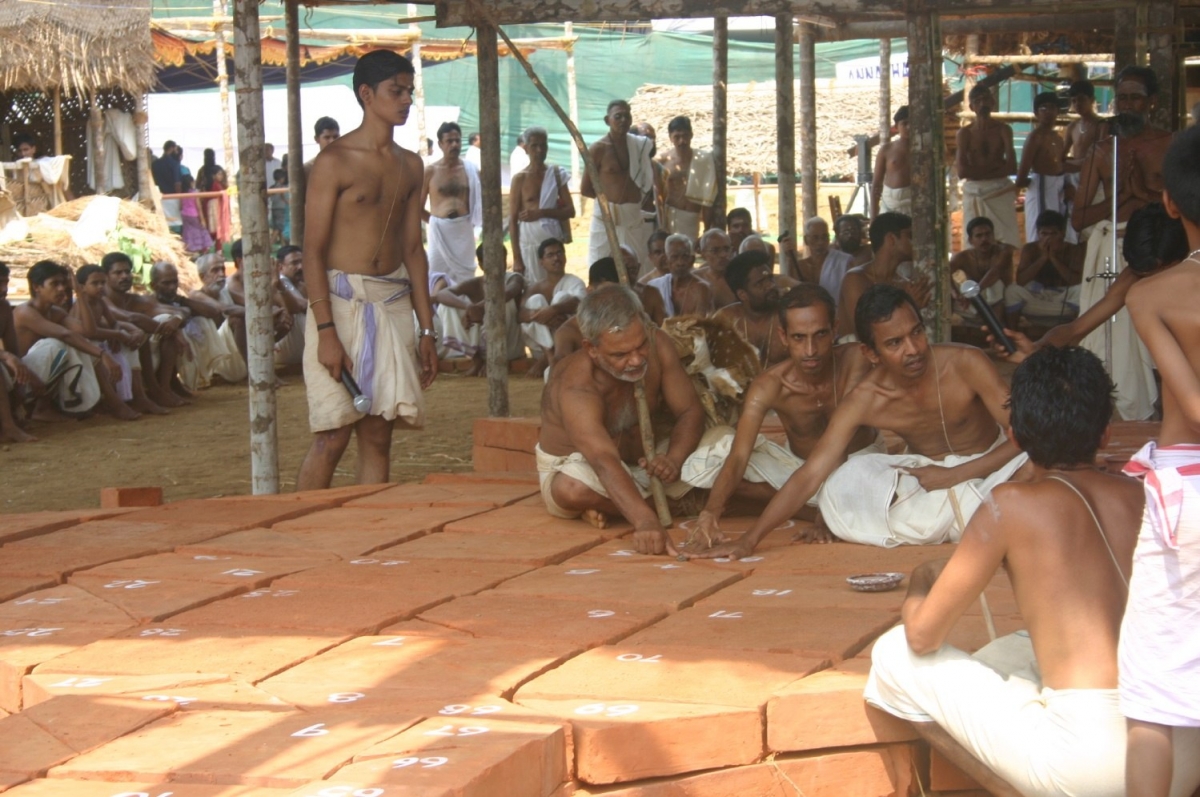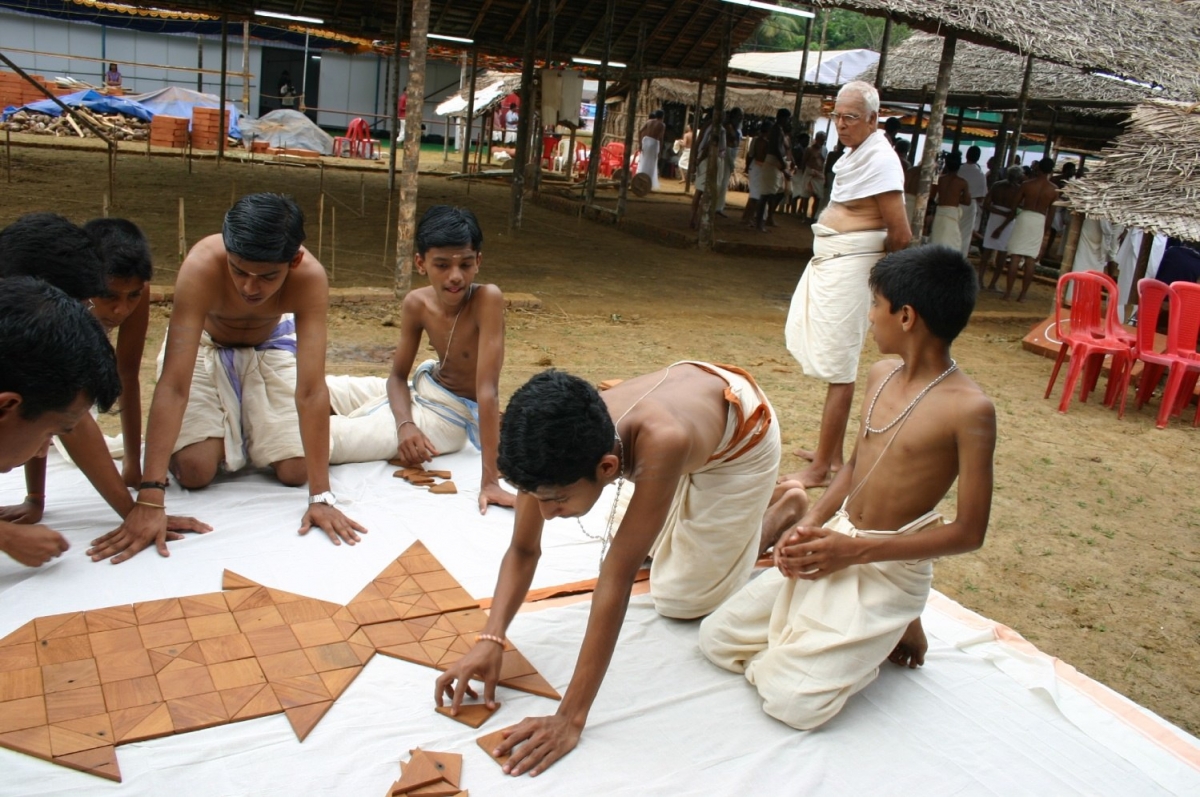[h=1]Ancient Indian Rope Geometry in the Classroom -[/h]Ancient Indian Rope Geometry in the Classroom Ancient Indian Rope Geometry in the Classroom - Mathematics in Ancient India ›
Author(s):
Cynthia J. Huffman (Pittsburg State University) and Scott V. Thuong (Pittsburg State University)
[h=3]Introduction[/h]

Cynthia J. Huffman (Pittsburg State University) and Scott V. Thuong (Pittsburg State University), "Ancient Indian Rope Geometry in the Classroom," Convergence (October 2015)

Figure 2. Boys working on a model of the bird-shaped fire altar in an Agnicayana ritual in 2011 in Panjal, Kerala. (Photo courtesy of Professor Michio Yano.)
Cynthia J. Huffman (Pittsburg State University) and Scott V. Thuong (Pittsburg State University), "Ancient Indian Rope Geometry in the Classroom - Mathematics in Ancient India," Convergence (October 2015)
Author(s):
Cynthia J. Huffman (Pittsburg State University) and Scott V. Thuong (Pittsburg State University)
[h=3]Introduction[/h]
Whether intentional or not, mathematics permeated many aspects of life for various ancient cultures, including religious aspects. For example, the Pythagoreans, a semi-religious secretive ancient Greek community, believed All is number. In order to build the religious temples and pyramids in ancient Egypt, the engineers and architects needed a working knowledge of basic geometry. In ancient China, mathematics was used in calendar development for knowing when to celebrate religious events. And in ancient India, geometry was used in constructing various religious altars.
It is the latter example that we focus on in this article. More specifically, we take a look at ancient Indian rope geometry used in the construction of altars for different fire sacrifices. GeoGebra applets are included to illustrate the ancient Indian rope geometry, as well as to allow the reader to explore. The article concludes with a collection of related activities that can be used in the classroom.

Figure 1. An Agnicayana fire sacrifice ritual in 2011 in Panjal, Kerala. This ritual, taking 12 days to perform, calls for a bird-shaped altar constructed out of 1005 bricks in homage to the god Agni. (Photo courtesy of Professor Michio Yano.)
Cynthia J. Huffman (Pittsburg State University) and Scott V. Thuong (Pittsburg State University), "Ancient Indian Rope Geometry in the Classroom," Convergence (October 2015)
There are difficulties encountered when one studies the history of mathematics in ancient India. Some of this is due to gaps in original source material. There are also discrepancies among secondary and tertiary sources. Additionally, at one point in the West, the history of Indian mathematics was often overlooked in favor of a more Eurocentric view. More recently, there have been efforts to correct this neglect with the publication of popular books for mainstream audiences like The Crest of the Peacock: Non-European Roots of Mathematics by George Gheverghese Joseph [Joseph], and more reliable specialized research by scholars such as Kim Plofker, author of Mathematics in India [Plofker2] and a chapter on Indian mathematics in The Mathematics of Egypt, Mesopotamia, China, India, and Islam: A Sourcebook, edited by Victor J. Katz [Plofker1]. For more information on the debate about Eurocentrism in the study of Indian mathematics, see Clemency Montelle’s review [Montelle] of The Crest of the Peacock.
The earliest evidence of ancient Indian mathematics dates back to 3000 BCE with the Harappan culture. [Joseph, p. 217] The earliest texts, dated during the second millennium BCE, are the Vedas, written in a form of Sanskrit. The word “Veda” translates as “knowledge.” In addition to hymns, these texts contain procedures for conducting religious rituals. [Plofker2, p. 5 and Plofker1, p. 385] Elements such as fire and water, as well as gods such as Agni (of fire) and Indra (of rain and thunderstorms) were worshiped in the religion of the Vedic period. The religious rituals involved the recitation of hymns and sacrifices. Priests performed these rituals for both nobles and wealthy commoners with the goal of enhancing fertility, wealth, and an afterlife shared with their ancestors. This style of worship is also seen today in the Hindu religion. There are a vast number of Vedic rituals, we mention only several. See the recent book by Shrikant Prasoon [Prasoon] for further discussion.
- The Agnistoma ritual involving the ceremonial beverage soma. The beverage soma was made by juicing the stalks of a certain plant, although the identity of this plant remains unclear, and is frequently speculated about. Soma imbued the drinker with immortality. For example, the gods Agni and Indra were said to drink soma.
- Rituals involving the construction of sacrificial fire altars. Examples include the Agnihotra, an oblation to Agni, as well as the Agnicayana.
- Healing rituals found in the Atharvaveda, a Veda on medicine.
- The Ashvamedha ritual for the prosperity of a nation.
- The Rajasuya, a ritual performed by a powerful king after a successful military campaign.

Figure 2. Boys working on a model of the bird-shaped fire altar in an Agnicayana ritual in 2011 in Panjal, Kerala. (Photo courtesy of Professor Michio Yano.)
As mentioned above, the focus of this article is on the construction of sacrificial fire altars in ancient India by means of rope geometry. Cryptic instructions for building these fire altars using measuring cords were given in the Vedic texts called Śulba-sūtras, which translates as “Rules of the cord.” According to Plofker [Plofker2, p. 16-18], there were four main Śulba-sūtras which are known by their authors’ names:
- Baudhāyana-śulba-sūtra, from the Middle Vedic period, about 800-500 BCE,
- Mānava-śulba-sūtra, also from the Middle Vedic period, about 800-500 BCE,
- Āpastamba-śulba-sūtra, from a time after the previous two but before the following,
- Kātyāyana-śulba-sūtra, possibly from the mid-fourth century BCE.
The dating of these writings is not certain, but is based on comparison of the style and grammar used in these texts with other texts. For more information on the Śulba-sūtras, see Mathematics in India by Kim Plofker [Plofker2] starting on page 16, and also page 387 and following in Chapter 4 of The Mathematics of Egypt, Mesopotamia, China, India, and Islam: A Sourcebook, edited by Victor J. Katz [Plofker1].
Cynthia J. Huffman (Pittsburg State University) and Scott V. Thuong (Pittsburg State University), "Ancient Indian Rope Geometry in the Classroom - Mathematics in Ancient India," Convergence (October 2015)

